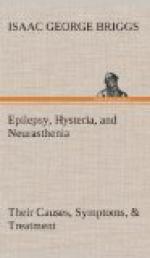Woodward’s Gripe Sodium Bicarbonate, Water. Caraway, and Syrup.
Atkinson and Barker’s Pot. and Magnesium Royal Infant Bicarbonate, several Preservative. Oils, and Syrup.
Mrs. Johnson’s American Spirits
of Salt, Common
Soothing Syrup. Salt, and Honey.
Convulsions During Pregnancy. Send for a doctor instantly.
Feigned Epilepsy is an all-too-common “ailment”. The false fit, as a rule, is very much overdone. The face is red from exertion instead of livid from heart and lung embarrassment, the spasms are too vigorous but not jerky enough, the skin is hot and dry instead of hot and clammy, the hands may be clenched, but the thumb will be outside instead of inside the palm, foam comes in volumes but is unmixed with blood, and the whole thing is kept up far too long. Almost before a crowd can gather an epileptic seizure is over, whereas the sham sufferer does not begin seriously to exhibit his questionable talents until a crowd has appeared.
Pressure on the eye, which will blink while the “sufferer” will swear; bending back the thumb and pressing in the end of the nail, when the hand will be withdrawn in feigned but not in true epilepsy; blowing snuff up the nose, which induces sneezing in the sham fit alone, or using a cold douche will all expose the miserable trick.
It is, unfortunately, far easier to suggest than to apply these tests, for anyone foolish enough to try experiments within reach of the wildly-waving arms will probably get such a buffet as will damp his ardour for amateur diagnosis for some time.
* * * * *
CHAPTER III
GENERAL REMARKS
“Do not muse at me, my most worthy friends;
I have a strange infirmity, which is nothing
To those that know me.”
“Macbeth,” Act III.
Starr’s table shows that combinations of all types of epilepsy are possible, and that mental epilepsy is rare:
Grand mal 1150
Grand and petit mal 589
Petit mal 179
Jacksonian 37
Mental 16
Grand mal and Jacksonian 10
Grand mal, petit mal and Jacksonian 8
Grand mal and mental 3
Grand mal, petit mal and mental 6
Petit mal and mental 2
Fits by day only 660
Fits day and night 880
Fits by night only 380
The majority of victims have attacks both by day and by night. Of 115,000 seizures tabulated by Clark, 55,000 occurred during the day (6 a.m. to 6 p.m.) and 60,000 by night.
The usual course of a case of epilepsy is somewhat as follows: the disease begins in childhood, the first convulsion, about the age of three, being followed some twelve months later by a second, and this again by a third within a few months. Then attacks occur more frequently until a regular periodicity—from one a day to one a year—is reached after about five years, and this frequently persists throughout life.




